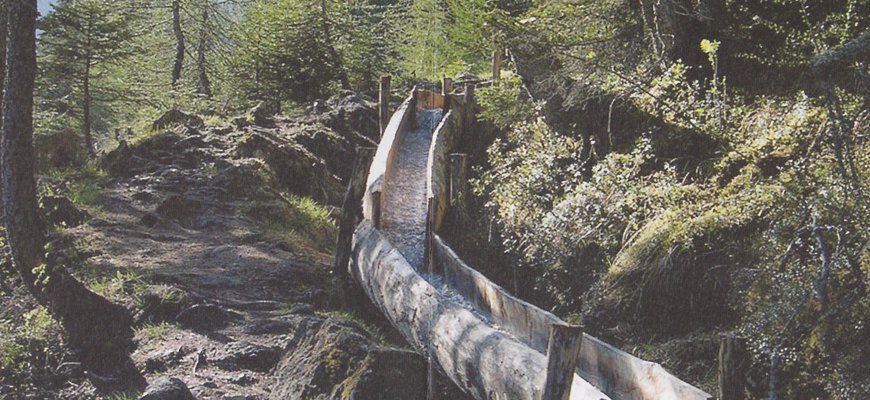Le Bief Bovet: 700 years of litigation

Most lawyers hope to get away from litigation on holiday. But for someone with an interest in legal translation this story was too good to miss. And more than 700 years of court proceedings over the same issue must surely be some sort of record!
The reputation of Haute Savoie as a holiday destination is largely on account of its skiing, but it also offers a wide range of opportunities for walking in summer. This particular walk, publicised in local guides, provided not only exercise and scenery but a lesson in local history… and more.
The Bovet Lade (“le Bief Bovet”) runs for several kilometres across a hillside in Haute Savoie, descending from 1,830 metres above sea level through the forests of Aime and Longefoy. At some points closely resembling a natural mountain stream, at others clearly a manmade watercourse (see image), it was built both to serve local mills and to provide a water supply to the population.
The lade dates from medieval times, being built between 1240 and 1242. It replaced an earlier watercourse supplying the village of Longefoy.
A footpath now runs along most of its length, and along this a series of signs records a sorry tale of 700 years of disputes and litigation between neighbouring communes. It is on the information recorded on these signs that much of this article is based.
Named after its architect, the lade was able to harness all the water downstream from Les Etroits (the mountainous area to the south). It appears to have been a great success, since its flow of 35 litres per second was 10 times what it had been previously.
But not long after the lade was put into operation, litigation arose between Longefoy and the neighbouring commune of Aime to the north, the latter no doubt finding its water supply severely depleted due to diversion of the natural watercourse.
Over decades and centuries attempts were made to resolve the dispute. In 1360 Count Amedée of Savoie granted authority to divert water from another stream, the Nant des Frasses, into the Bief Bovet, and appointed a local nobleman, Sieur Montmayeur, to share the supply equitably between Aime and Longefoy.
So far so good. But on 17 June 1406 the commune of Aime launched further proceedings against Longefoy, disputing the authorisation of 1360. The judgment of the court appointed a new arbiter, local landowner Caucoz de Revers.
In 1550 proceedings were revived, this time before the justice of the peace of Aime, and a number of violent incidents arose between the inhabitants of Longefoy and the neighbouring hamlet of Revers. In 1568 local forces of law and order took up position for several months at Envers (the area immediately north and east of the Bief) to keep the peace. In 1569 the commune of Longefoy was censured, having been found guilty of diverting the stream.
By a decree of 14 February 1577 the Senate (of Savoie, which was not then part of France) determined that Longefoy should remain in possession of the water from Les Etroits, and Aime that from Envers.
Two centuries on
In 1785, Longefoy excavated a channel taking water from Envers upstream of the intake to the lade. The Commune of Aime responded by appealing to the Senate by petition dated 3 June 1786. Each municipality had a plan of localities and springs drawn up by geometricians. Unfortunately, as so often seems to occur when expert witness are engaged by opposing sides, the two plans were in complete disagreement. In consequence, nothing was resolved. Perhaps because of political upheaval around that time, the case dragged on until at least 1792, and indeed may never have been concluded.
It was in that year that Savoie formally became a French département, although it was not until 1860 that its inhabitants opted by referendum to become part of France, rather than Italy. Whether the channel remained in place over this period is not clear. But in 1838 Longefoy re-excavated it, thus gaining possession of most of the water supply. Not for long, however, for soon after that the commune of Aime, apparently with a court decision behind it, once more demolished the channel.
In 1840 Aime acquired the land at Revers that had many years before belonged to Caucoz, and from then until 1842 a scheme of apportionment between the communes according to need operated successfully.
In 1843, however, this short truce was broken: two inhabitants of Revers were caught red-handed blowing up the wooden barrier that divided the water supplies, thereby giving it all to Revers!
In 1847 further attempts were made at resolution after various proceedings between the two communes. With the help of a wooden cistern, Architect Borel carried out a study to measure the flow of the springs in the two communes at three points in the year: the end of March, the beginning of August and the end of November. A census was carried out of all inhabitants of the local villages and hamlets, and of their livestock, which in itself is an intriguing record of the pastoral society of the time, and their respective consumption was calculated.
None of this, however, appears to have been in any way conclusive, for in August 1862 Longefoy engaged a stonemason from Champagny, Jean-Marie Chapuis, to build a watertight barrier to divert the entire water supply, cutting off Aime completely. The court action which followed that bold step lasted 40 years.
On 7 August 1876 the Court of Appeal from Chambéry, comprising two judges, a clerk, and two experts, travelled to Envers – a journey of three days on horseback, with the final stage by sedan-chair from Aime. Over a period of three days this tribunal heard 23 witnesses for Aime and 13 for Longefoy. The Aime witnesses gave evidence of having seen a barrier diverting the water from the stream to the lade.
At the opening of the hearing of witnesses for Longefoy the lawyer acting for Aime objected to the admissibility of their evidence on the ground that they had been fed and lodged at the expense of Longefoy for the previous three days. Indeed, maintenance payments had been made by the Mayor of Aime to witnesses for the commune. Furthermore, one witness declared that the innkeeper had assured him that “the commune was paying” for his drinks. Another gave evidence that he had received a gift from the mayor to go to eat sérac (a white alpine cheese) and milk at Prajourdan, the meadow area around the start of the lade.
Giving judgment, the Court of Appeal returned the Envers springs to Aime. Longefoy took the matter to the Court of Justice at Grenoble, but this simply confirmed the judgment of the Chambéry court.
Despite this, the commune of Longefoy seems to have remained determined to rebuild the barrier, and the matter went before the Supreme Court at Lyon. The bailiff sent to serve a citation on the Mayor of Longefoy was unable to trace either him or his deputies. One of the local councillors took a copy of the citation, refused to sign the original, then seized it from the hands of the bailiff and fled with the lot!
All to little avail. The court found against Longefoy by default and ordered it to construct a new barrier designed to divide the water supply fairly between the communes.
Back to the start
Still the matter was not allowed to rest. Efforts were even made to trace documents in Turin relating to the construction of the lade in 1240, but nothing was found.
An attempt was also made to identify the natural course of the water. In the presence of judges and of the two mayors, pieces of paper were put in the water upstream from the entrance to the lade. These proceeded towards Aime, and not into the lade. The experiment then descended into farce, for the Mayor of Longefoy refused to admit what had occurred, claiming that he did not have his spectacles. He produced 10 pages of certificates to the judges to establish his inability to see without these.
A further agreement to share the water supply was reached in 1901 between the communes, but this in turn collapsed in 1904 with fresh proceedings.
Here the signpost narrative ends, on what seems a note of exasperation. But was the dispute ever resolved? Well, technically not, it seems. It dragged on until finally in 1973 the two communes were amalgamated. But one wonders whether that really settled anything… Is there more to come?
(To minimise the risk of further litigation, please note that the path is rough and steep at some points. Good footwear is advised!)
In this issue
- Good health – fair question?
- Time to raise the age of criminal responsibility
- Adoption of foreign children – a clash of cultures?
- Presumed liability: the case for action
- Le Bief Bovet: 700 years of litigation
- Reading for pleasure
- Opinion: James O'Reilly (fuller version)
- Opinion: James O'Reilly
- Book reviews
- Profile
- President's column
- Land Register completion update
- People on the move
- Conference calls
- A new court rises
- Questions of form
- Charities - why reserves matter
- Place your bets
- Pensions: a formula unravelled
- Whereabouts unknown?
- Lego Man keeps his mark
- The company one keeps
- Scottish Solicitors Discipline Tribunal
- Land, leases and LBTT
- Big budget brief
- Support sought as Napier joins the law clinics
- Public Guardian's fees to increase
- Law reform roundup
- TCPD: the Update way
- How are we doing?
- Thanks, but no thanks
- Ask Ash






